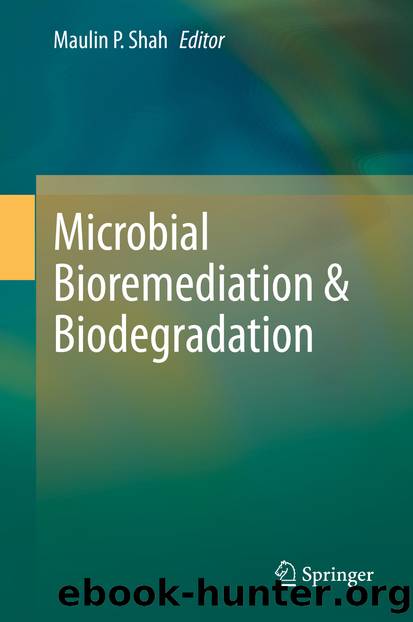Microbial Bioremediation & Biodegradation by Unknown

Author:Unknown
Language: eng
Format: epub
ISBN: 9789811518126
Publisher: Springer Singapore
11.3.2 Biological Treatments
Biological treatment of wastewater is usually termed as bioremediation. Bioremediation is the use of biological system such as microorganisms (bacteria, yeast, filamentous fungi, Actinomycetes, and algae) or their enzymes for the removal and/or breakdown of xenobiotics (synthetic organic chemical compounds).
These processes are energy dependent and take advantage of the biochemical reactions taking place in living system and their enzymes for the breakdown of polluting agents (organopollutants) into different products. Biological methods can lead to complete mineralization of organic pollutants at low cost, and above all they are considered environmentally friendly (Pandey et al. 2007). They also get rid of BOD, COD, and suspended solids. The main limitation with some dyes and/or their degradation products may be toxicity to the organisms used in the process. Yaseen and Scholz (2017) recommended shallow wetland systems planted with aquatic plants for the treatment of wastewater containing dyes. However, use of such treatments is limited and was in use for a short time period (Muthunarayanan et al. 2011; Sivakumar et al. 2013). Percentage and type of dyes in the textile effluents depends on their degree of fixation with the fabric (Carmen and Daniela 2012). Treatment performances of textile dye effluents by electrochemical oxidation (Randazzo et al. 2011), ozonation (Wijannarong et al. 2013), biosorption (Guendouz et al. 2016), bacterial degradation (Kolekar et al. 2013), and fungal degradation (Taha et al. 2014) have been reported.
Kagalkar et al. (2010), Khandare et al. (2011), and Kabra et al. (2012) have reported the application of Aracheae, Portulacaceae, and Glandularia pulchella for phytoremediation, respectively. The microbial degradation and biosorption of dyes are often economical and eco-friendly as compared to physical and chemical processes as they (biodegradation) may lead to complete mineralization of dyes (Pandey et al. 2007) (Table 11.7).Table 11.7Biological treatment methods used for wastewater treatment with their advantages and limitations (Table adopted from Zaharia et al. 2012)
Download
This site does not store any files on its server. We only index and link to content provided by other sites. Please contact the content providers to delete copyright contents if any and email us, we'll remove relevant links or contents immediately.
| Automotive | Engineering |
| Transportation |
Whiskies Galore by Ian Buxton(40331)
Introduction to Aircraft Design (Cambridge Aerospace Series) by John P. Fielding(32338)
Small Unmanned Fixed-wing Aircraft Design by Andrew J. Keane Andras Sobester James P. Scanlan & András Sóbester & James P. Scanlan(32141)
Craft Beer for the Homebrewer by Michael Agnew(17446)
Turbulence by E. J. Noyes(7039)
The Complete Stick Figure Physics Tutorials by Allen Sarah(6638)
Kaplan MCAT General Chemistry Review by Kaplan(6053)
The Thirst by Nesbo Jo(5785)
Bad Blood by John Carreyrou(5769)
Learning SQL by Alan Beaulieu(5411)
Weapons of Math Destruction by Cathy O'Neil(5036)
Man-made Catastrophes and Risk Information Concealment by Dmitry Chernov & Didier Sornette(4735)
iGen by Jean M. Twenge(4702)
Digital Minimalism by Cal Newport;(4540)
Life 3.0: Being Human in the Age of Artificial Intelligence by Tegmark Max(4507)
Audition by Ryu Murakami(4099)
1,001 ASVAB Practice Questions For Dummies by Powers Rod(4038)
Electronic Devices & Circuits by Jacob Millman & Christos C. Halkias(4027)
Pale Blue Dot by Carl Sagan(4001)
